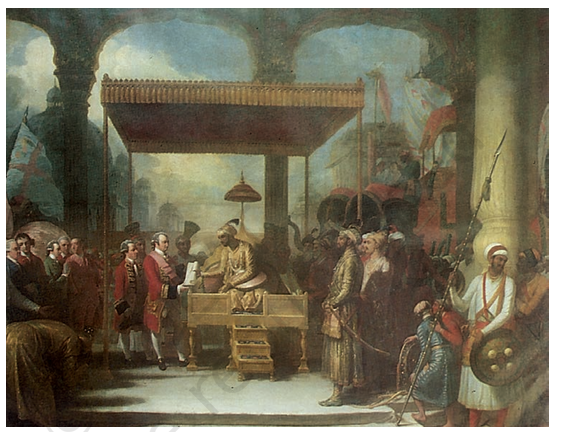Ruling The Countryside- Complete Guide For Class 8 History Chapter 3
Our learning resources for the chapter, “Ruling The Countryside” in History for Class 8th are designed to ensure that you grasp this concept with clarity and perfection. Whether you’re studying for an upcoming exam or strengthening your concepts, our engaging animated videos, practice questions and notes offer you the best of integrated learning with interesting explanations and examples.
The chapter “Ruling the Countryside” from the Class 8 History delves into the strategies and policies employed by the British East India Company to control and manage Indian agrarian societies. This chapter “Ruling the Countryside” highlights the significant changes in land revenue systems, agricultural practices, and the impacts on Indian peasants and zamindars. Understanding “Ruling the Countryside” is crucial for comprehending how colonial rule reshaped India’s rural economy and society, laying the groundwork for subsequent agrarian transformations.
Now that we know the importance of studying this chapter, let’s understand the objectives behind studying “Ruling the Countryside”.
- To understand how the British East India Company assumed administrative control over Bengal and implemented the Permanent Settlement.
- To examine how the British transformed Indian agriculture to prioritize cash crops for European markets, impacting local food security and farmers’ livelihoods.
- To explore the causes, events, and consequences of the Blue Rebellion of 1859-60 and its impact on British colonial policies and indigo cultivation in Bengal.
Let’s now understand these objectives in detail.
The Company Becomes the Diwan
- In this section, “Ruling the Countryside” examines how the British East India Company assumed the role of Diwan of Bengal in 1765, marking the beginning of British control over Indian territories.
- As Diwan, the Company was responsible for administering the land revenue system.
- The chapter “Ruling the Countryside” describes how the Company implemented the Permanent Settlement in 1793, which fixed the land revenue that zamindars had to pay.
- This system aimed to create a stable source of revenue for the British but often led to the exploitation of peasants, as zamindars were pressured to extract more revenue.
- The chapter also covers the Mahalwari System and the Munro System, which were introduced in different regions to address issues arising from the Permanent Settlement.

Let us understand the key points included in this section to gain a deeper insight into the changes brought by the British administration mentioned in the chapter “Ruling the Countryside“:
- The Introduction of the Permanent Settlement:
The chapter “Ruling the Countryside” discusses the Permanent Settlement system, introduced in 1793, which fixed the land revenue that zamindars had to pay to the Company. The Permanent Settlement aimed to create a stable source of revenue for the British, but often led to the exploitation of peasants as zamindars struggled to meet their revenue targets. This aspect of “Ruling the Countryside” highlights the financial pressures and systemic issues introduced by British policies.
- The Roles and Responsibilities of Zamindars: Under the Permanent Settlement, as detailed in the chapter “Ruling the Countryside,” zamindars were made responsible for collecting land revenue from the peasants. While the zamindars gained ownership rights, they were also pressured to extract high revenues, leading to conflicts and tensions with the peasants. The chapter “Ruling the Countryside” elaborates on the dual role of zamindars as both beneficiaries and enforcers of British policies.
- The Impact on Peasants and Agricultural Productivity: The chapter “Ruling the Countryside” explains that the fixed revenue demands placed heavy burdens on peasants, leading to widespread poverty and indebtedness. Agricultural productivity suffered as peasants were unable to invest in their lands, and frequent famines further exacerbated their hardships. “Ruling the Countryside” underscores the detrimental effects of British land revenue policies on the agrarian economy and rural society.
- The Mahalwari System, implemented in areas like the north-western provinces, involved a revenue assessment based on the entire village or mahal. The Munro System, named after its architect, was introduced in the Madras Presidency and aimed to provide a more flexible approach to revenue collection by assessing land individually rather than through zamindars.

Now, let’s learn about the section “Crops for Europe” in the chapter “Ruling the Countryside” to understand how British agricultural policies influenced Indian farming practices and the local economy.
Crops for Europe
- This section of “Ruling the Countryside” explores how the British sought to transform Indian agriculture to meet the demands of the European market.
- The chapter “Ruling the Countryside” details the cultivation of cash crops like indigo, tea, and opium, which were in high demand in Europe.
- The British encouraged or forced Indian farmers to grow these crops, often at the expense of food crops.
- “Ruling the Countryside” highlights the adverse effects on Indian farmers, who faced debt and poverty due to fluctuating market prices and oppressive cultivation contracts.
Let us explore the key points in the section “Crops for Europe” from the chapter “Ruling the Countryside” to understand the impact of British policies on Indian agriculture:
- The Focus on Cash Crops and Their Impact on Food Security: The chapter “Ruling the Countryside” highlights how the British shifted Indian agriculture towards the cultivation of cash crops like indigo, tea, and opium. This focus on cash crops diminished the production of food crops, severely affecting food security. As a result, there were shortages and increased prices for staple foods, which led to widespread distress among local populations.

- The Role of the British in Promoting Indigo, Tea, and Opium Cultivation: In “Ruling the Countryside,” it is explained that the British actively promoted the cultivation of indigo, tea, and opium to meet European market demands. The British enforced policies and contracts that forced Indian farmers to grow these cash crops, often at the expense of their own subsistence needs. Additionally, the chapter “Ruling the Countryside,” details the promotion of nij cultivation, where British planters directly controlled land and production of indigo, leading to even greater exploitation of local farmers.

- The Economic Hardships Faced by Indian Farmers: The chapter “Ruling the Countryside” also addresses the economic hardships faced by Indian farmers as a result of the focus on cash crops. Farmers were often left in debt due to unfavorable terms imposed by British planters and fluctuating market prices for cash crops. This led to widespread poverty and economic instability, highlighting the severe impact of British agricultural policies on rural communities.
Now, let’s learn about the section “The Blue Rebellion and After” from the chapter “Ruling the Countryside” to understand the causes of the uprising, the British response, and its long-term effects on indigo cultivation and colonial policies.
The Blue Rebellion and After
The final section of “Ruling the Countryside” discusses the Blue Rebellion of 1859-60, a significant uprising by indigo farmers against oppressive British planters. The chapter describes how farmers resisted the harsh conditions imposed by indigo cultivation and the subsequent decline in indigo production in Bengal. The rebellion forced the British to reconsider their policies and eventually led to the end of the indigo cultivation system in Bengal. “Ruling the Countryside” underscores the importance of this rebellion as a symbol of resistance against colonial exploitation.
Let’s explore the key points in the section “The Blue Rebellion and After” from the chapter “Ruling the Countryside” to understand the significance of this uprising and its impact on British colonial policies:
- The Causes and Consequences of the Blue Rebellion: The chapter “Ruling the Countryside” explains that the Blue Rebellion of 1859-60 was sparked by widespread resentment among indigo farmers (ryots) against the harsh conditions imposed by British planters and their agents, known as gomasthas. These farmers were forced into unfavorable contracts and faced extreme exploitation. The rebellion led to violent clashes and significant upheaval, exposing the brutal realities of indigo cultivation.

- The Response of the British Administration: In response to the Blue Rebellion, the British administration took measures to suppress the uprising and restore order. The chapter “Ruling the Countryside” details how the British used military force to quell the rebellion and subsequently made some concessions to address the grievances of the farmers. However, these responses were more about maintaining control than genuinely resolving the issues faced by the ryots.
- The Long-Term Impact on Indigo Cultivation and Colonial Policies: The chapter “Ruling the Countryside” also discusses the long-term effects of the rebellion on indigo cultivation and British colonial policies. Following the rebellion, the British began to phase out the indigo cultivation system in Bengal, recognizing the unsustainable nature of their exploitative practices. The rebellion had a lasting impact on colonial policies, leading to reforms aimed at improving conditions for farmers and adjusting revenue systems.

Conclusion
The chapter “Ruling the Countryside” offers an insightful look into the British administration’s impact on India’s rural landscape. By understanding the land revenue policies, the shift towards cash crops, and the resistance movements like the Blue Rebellion, students gain a comprehensive view of how colonial rule reshaped Indian agrarian society. This chapter serves as a crucial component of understanding India’s colonial history and its lasting effects on the countryside.
Practice questions on Chapter 3 - Ruling The Countryside
Get your free Chapter 3 - Ruling The Countryside practice quiz of 20+ questions & detailed solutions
Practice Now








